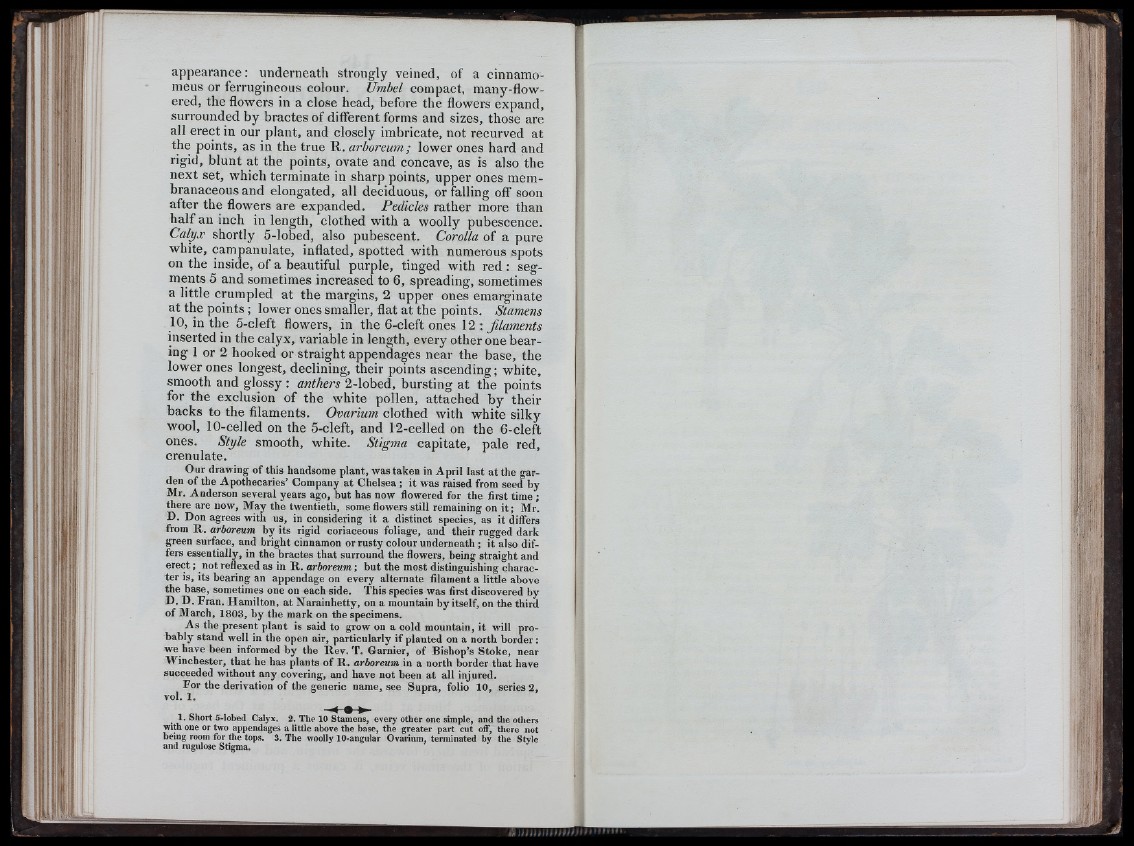
I I
appearance: underneath strongly veined, of a cinnamo-
mens or ferrugineous colour. Umbel compact, many-flowered,
the flowers in a close head, before the flowers expand,
surrounded by bractes of different forms and sizes, those are
all erect in our plant, and closely imbricate, not recurved at
the points, as in the true R. arboreum; lower ones hard and
rigid, blunt at the points, ovate and concave, as is also the
next set, which terminate in sharp points, upper ones membranaceous
and elongated, all deciduous, or falling off soon
after the flowers are expanded. Pedicles rather more than
half an inch in length, clothed with a woolly pubescence.
Calyx shortly 5-lobed, also pubescent. Corolla of a pure
white, campanulate, inflated, spotted with numerous spots
on the inside, of a beautiful purple, tinged with red: segments
5 and sometimes increased to 6, spreading, sometimes
a little crumpled at the margins, 2 upper ones emarginate
at the points; lower ones smaller, flat at the points. Stamens
10, in the 5-cleft flowers, in the 6-cleft ones 1 2 Jilaments
inserted in the calyx, variable in length, every other one bearing
1 or 2 hooked or straight appendages near the base, the
lower ones longest, declining, their points ascending; white,
smooth and glossy : anthers 2-lobed, bursting at the points
for the exclusion of the white pollen, attached by their
backs to the filaments. Ovarium clothed with white silky
wool, 10-celled on the 5-cleft, and 12-celled on the 6-cleft
ones. Style smooth, white. Stigma capitate, pale red,
crenulate.
Our drawing of this handsome plant, was taken in April last at the garden
o f the Apothecaries’ Company at Chelsea; it was raised from seed by
Mr. Anderson several years ago, but has now flowered for the first time ;
there are now. May the twentieth, some flowers still remaining on it; Mr.
D . Don agrees with us, in considering it a distinct species, as it differs
from R . arboreum by its rigid coriaceous foliage, and their rugged dark
green surface, and bright cinnamon or rusty colour underneath; it also differs
essentially, in the bractes that surround the flowers, being straight and
e r e c t; not reflexed as in R . arboreum; but the most distinguishing character
is, its hearing an appendage on every alternate filament a little above
the base, sometimes one on each side. This species was first discovered by
D . D . Fran. Hamilton, at N arainhetty, on a mountain by itself, on the third
o f March, 1803, by the mark on the specimens.
A s the present plant is said to grow on a cold mountain, it will probably
stand well in the open air, particularly if planted on a north border:
we have been informed by the Rev. T. Gamier, o f Bishop’s Stoke, near
Winchester, that he has plants o f R . arboreum in a north border that have
succeeded without any covering, and have not been at all injured.
For the derivation o f the generic name, see Supra, folio 10, series 2,
vol. 1.
1. S ho rt 5-lobed Calyx. 2 . The 10 Stamens, ev ery other one simple, and th e others
with one or two appendages a little above the base, the g rea ter part cu t off, th ere not
b eing room for the tops. 3. Th e woolly 10-angular Ovarium, terminated by the Sty le
and rugulose Stigma.
!